.svg)
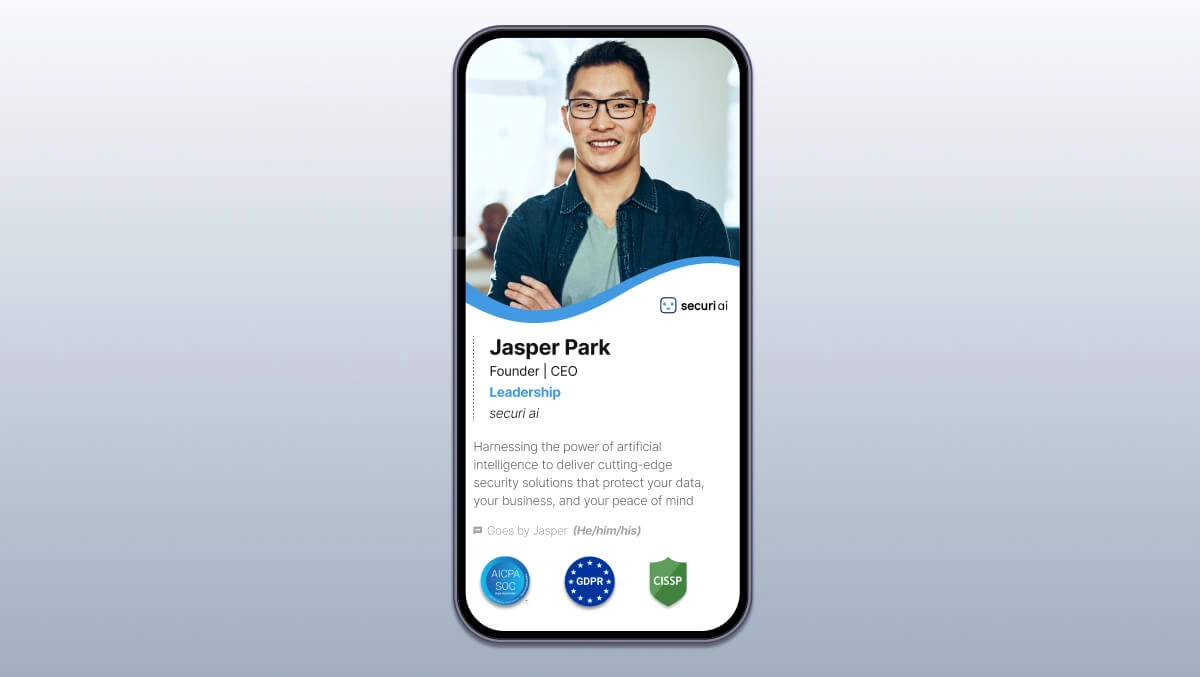
Networking digitally seems simple, yet sharing contact information quickly and professionally often feels clunky or inconsistent. HiHello digital business card has become a go-to solution, offering sleek, customizable cards and seamless contact sharing. But even with its popularity, some users find themselves looking for more, whether it’s advanced team features, deeper customization, or better integrations. That’s why we’ve explored 17 alternatives to HiHello that push beyond its limitations and deliver smarter ways to connect.
Mobilo's digital business card offers simple contact sharing, easy CRM sync, customizable profiles, and lead capture analytics to help you collect and manage contacts without extra steps.

HiHello is a digital business card platform built to replace paper cards and centralize contact sharing. Users build hosted digital business cards on HiHello and include phone numbers, email addresses, social profiles, website links, messenger apps like Telegram or WhatsApp, plus images and media.
You can hand someone a QR code, send a short URL, or tap an NFC tag to share your card in seconds. Uses it for Professionals who meet clients, distributed teams that need consistent branding, and organizations that want a directory solution and analytics.
You create one or more digital business cards in the app or on the web dashboard, customize fields and layout, then share via QR codes, links, AirDrop, Apple Wallet, email signature, a widget, or NFC tags.
Recipients open a card in a browser or the HiHello app and save the contact information to their phone. HiHello records sharing events and contact saves so you can track opens, clicks, and lead activity with built in analytics and export options.
HiHello runs on mobile and desktop so you can manage cards on the go or from a browser.
The web dashboard is useful for teams to view analytics, manage user directories, and configure integrations from a desktop.
HiHello packs networking centric tools that make contact sharing fast and consistent.
HiHello stands out for its breadth of sharing choices. Branded QR codes and short links work for public networking. NFC support and Apple Wallet provide one tap interactions for in person meetings. Widgets and auto insertion into email signatures speed distribution in daily workflows.
In daily use the HiHello app performs smoothly. The interface responds quickly, scans process without noticeable lag, and sharing actions complete reliably. These behaviors make it practical for back to back meetings and conference use where speed matters.
HiHello uses a clean minimalist interface that focuses on clear icons and simple navigation. Sign-in options include email, Google, Apple, Microsoft, and Facebook so setup goes fast. The app divides tasks into obvious tabs such as:
The web dashboard mirrors core functions and gives admins analytics and user controls on a larger screen.
HiHello follows enterprise-class security controls and maintains SOC 2 Type II compliance. The platform aligns with GDPR readiness and applies standard protections for stored contact data. App permissions are limited to what the features need, typically access to photos for uploads and, optionally to device contacts for syncing. Teams that require SSO and directory sync can enable those features on business or enterprise plans.
HiHello offers multiple tiers to fit individuals and organizations.
Pricing reflects the product focus on teams and CRM workflows where integration and admin controls add measurable value.
When a card is shared and a recipient saves it, HiHello records the interaction and can push the contact to Google Contacts or Outlook. Zapier support lets you automate actions such as creating leads in HubSpot or Salesforce, adding contacts to email campaigns, or sending welcome messages. For sales teams, this reduces manual entry and speeds follow-up.
HiHello issues regular updates to improve stability and add features. The development cadence has included new templates, expanded sharing modes, and scanner improvements. AI-driven scanning is present but limited by plan level and scope at this time.
Pros:
Cons:

Intelligent business cards that auto-capture, enrich, and route leads straight to your CRM. Mobilo presents a clear alternative to HiHello by combining physical NFC and fully digital sharing with automated lead enrichment, lead scoring against your ideal customer profile, and native CRM sync.
The platform targets sales and marketing teams that need consistent data capture at events, with centralized admin controls, analytics, and campaign-level reporting to measure ROI from networking.
What sets Mobilo apart is its mix of hardware and software. It supports tap to share, QR code and link sharing, and built-in badge scanning at events. Automated contact enrichment pulls firmographic and intent signals so sales teams spend time on prospects that matter.
Admin dashboards let managers provision cards, enforce brand templates, and export clean contact lists. There are built-in analytics for capture rates, event performance, and team activity so networking becomes measurable rather than ad hoc.
What works:
Best for sales-driven teams and enterprises that need reliable lead capture and CRM sync from every networking moment.

Blinq offers a free digital business card with quick sharing features and a simple setup. It works well for casual users who want a basic virtual business card, shareable link, or QR code. The platform lacks the depth, reliability, and enterprise features that growing teams require. If your priority is centralized management, custom templates, or secure CRM integrations, Blinq falls short.
What works:
Where it falls short:
Blinq is fine for single users who need a simple virtual business card but not for teams that require centralized management or advanced integrations.

Popl offers digital business cards but currently focuses on event-based networking. It blends tap to share and social-oriented features, which makes it friendly for casual meetups and trade shows. Yet its frequent product pivots and limited customization mean it may not suit professionals who want a reliable, full-time digital business card. If everyday networking is your need, Popl’s focus may feel narrow.
What works:
Where it falls short:
Popl fits event-driven networking but is not the most versatile choice for professionals who need a full-featured digital business card platform.

Linq promotes NFC business cards as the future of networking, emphasizing tap to share experiences. The hardware feels modern, but NFC has clear compatibility gaps and requires carrying a physical card. Linq adds some lead generation tools for events, yet missing visibility into card views and limited customization reduces its appeal for professionals who need full digital features.
What works:
Where it falls short:
Linq is a decent NFC solution for those who prioritize tap to share, but it is limited for professionals who need flexible, fully digital contact sharing and analytics.
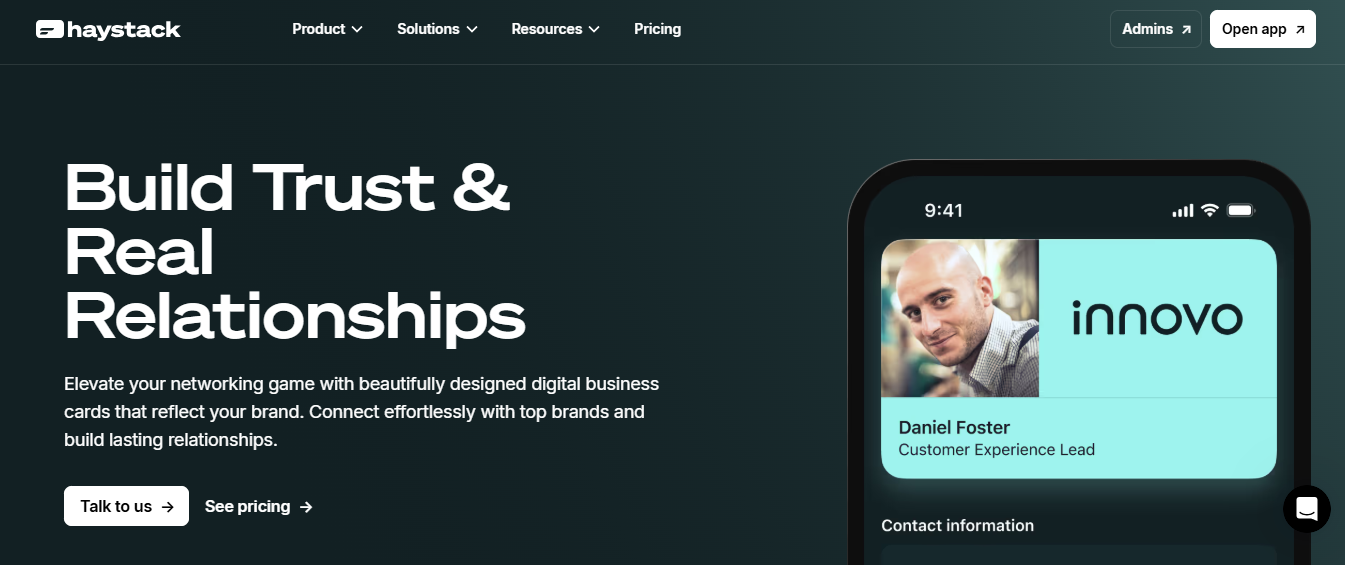
Haystack positions itself as a sustainable, paperless business card solution and functions mainly as a contact repository. It appeals to users focused on reducing paper, but the platform lacks deep customization, rich integrations, and advanced networking features offered by modern digital business card platforms. The experience leans basic rather than strategic.
What works:
Where it falls short:
Haystack suits users looking to ditch paper but not for professionals who want a modern, feature-rich digital business card platform.

Uniqode is primarily a QR code provider with digital business cards as a secondary offering. It handles dynamic QR needs and auditing well, but without a mobile app it becomes clumsy for on-the-spot sharing and updates. Organizations needing strict control over employee cards may like its permission model, yet the lack of real-time usability hampers networking.
What works:
Where it falls short:
Uniqode fits teams that need enterprise QR control but not professionals who want a flexible, app-driven digital business card.

CamCard began as a card-scanning app and still does that well. It helps users convert paper business cards into digital contacts and supports multiple languages, which is valuable for international professionals. Its digital business card features remain basic and the overall platform feels dated compared with contemporary virtual card services.
What works:
Where it falls short:
CamCard is useful if you still collect paper cards, but not if you want a modern digital business card platform with CRM and team features.
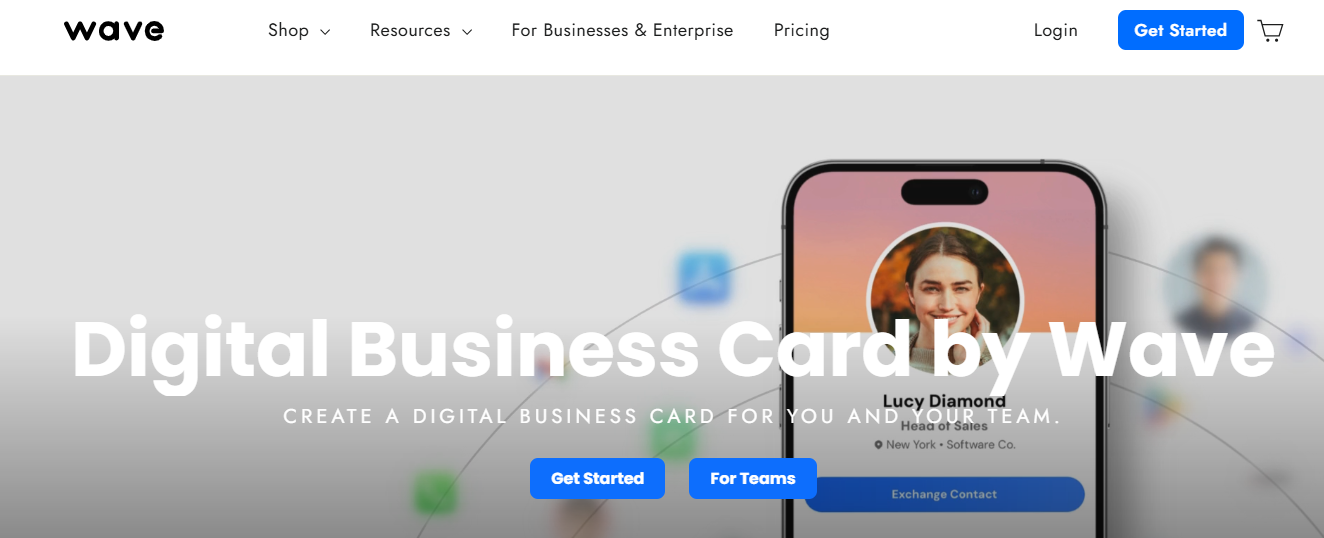
Wave Connect offers a polished NFC card and a built-in card scanner, but basic customization and useful features are often behind paywalls. The minimal aesthetic appeals visually, yet the app navigation and restricted free tier reduce its practical value compared with platforms that include more tools at no cost.
What works:
Where it falls short:
Wave Connect appeals to design-oriented users who accept paywalls but falls short for those who need full digital features without constant upsells.
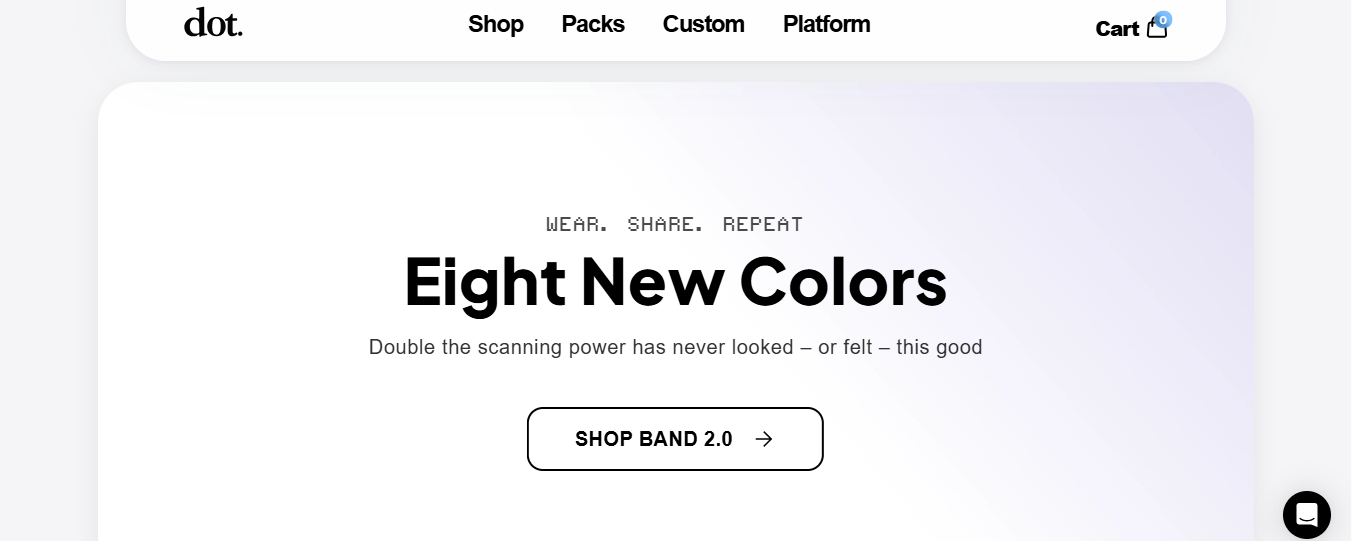
Dot sells NFC cards and promotes a simple tap-to-share experience, but it does not provide a strong software companion. Without a mobile app or robust dashboard, updates are limited and cards behave more like static links than evolving digital business cards. If you want a dynamic card that updates and integrates, Dot will frustrate you.
What works:
Where it falls short:
Dot can work for buyers who want a basic NFC card but not for anyone needing a flexible, integrated digital business card platform.
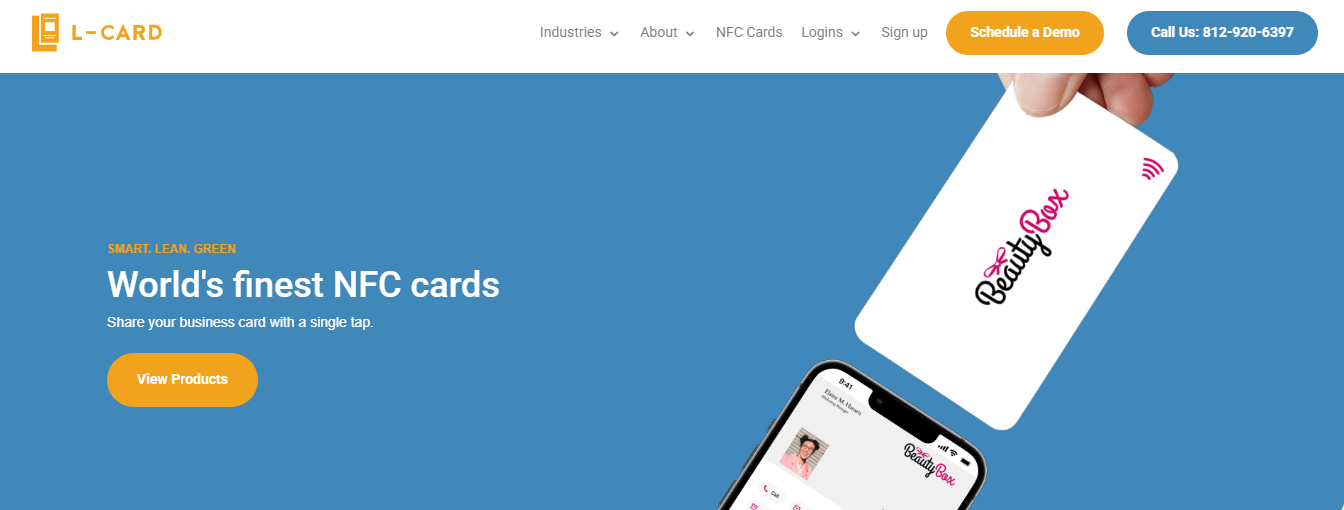
L Card started as a business card scanning app and added digital card features, but the product still centers on scanning. The free plan includes a modest number of scans and the platform supports testimonials on cards, yet design and usability lag behind modern competitors. Teams seeking a sleek, unified platform will likely look elsewhere.
What works:
Where it falls short:
L Card helps digitize paper cards but does not deliver the polished, modern digital business card experience many professionals want.
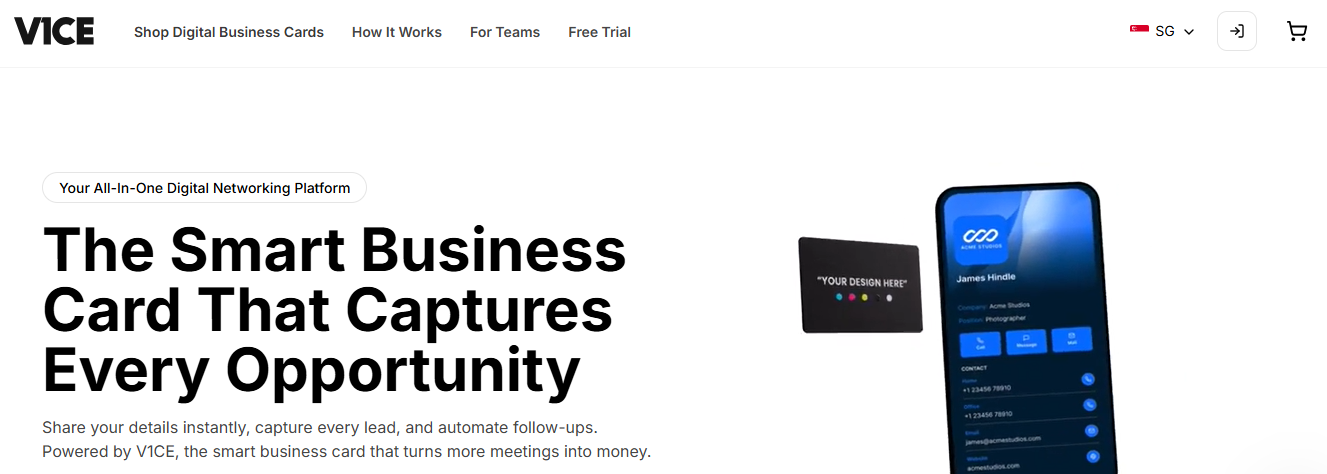
V1CE markets premium NFC cards made from metal, bamboo, and even plated finishes, giving a memorable tactile impression. The digital side of the product is essentially a landing page with limited features, and there is no mobile app to edit and share on the fly. If you want the luxury feel but need full digital features, V1CE may disappoint.
What works:
Where it falls short:
V1CE is compelling for those who want luxury NFC cards but not for teams that need comprehensive digital business card capabilities.

Tap sticks to a straightforward tap to share model and offers clear one-time pricing. The hardware selection includes some creative card styles and payment clarity. Tap lacks CRM integrations, comprehensive lead capture, and team features that sales organizations expect from a full-featured digital business card platform.
What works:
Where it falls short:
Tap works for buyers who want a physical NFC card with straightforward use but not for teams needing integration and analytics.

Tapt positions itself as a next-generation networking tool but the product centers on NFC hardware and a clunky user interface. It does offer CRM integrations and admin controls for teams, yet the overall experience is hampered by slow support and a design that feels copied without refinement. Teams may find the basic features useful but will struggle with usability.
What works:
Where it falls short:
Tapt provides basic NFC and team features but suffers from usability issues that limit its appeal for teams needing smooth workflows.

Kado Network offers a secure and simple way to share contact details with multiple sharing methods. It is SOC 2 and GDPR compliant and provides QR codes, links, and in-app sharing. Limited design flexibility and a lack of enterprise integration make it better suited for independent professionals than for scaling businesses.
What works:
Where it falls short:
Kado suits solo professionals focused on secure sharing but not companies that need integrations and centralized controls.
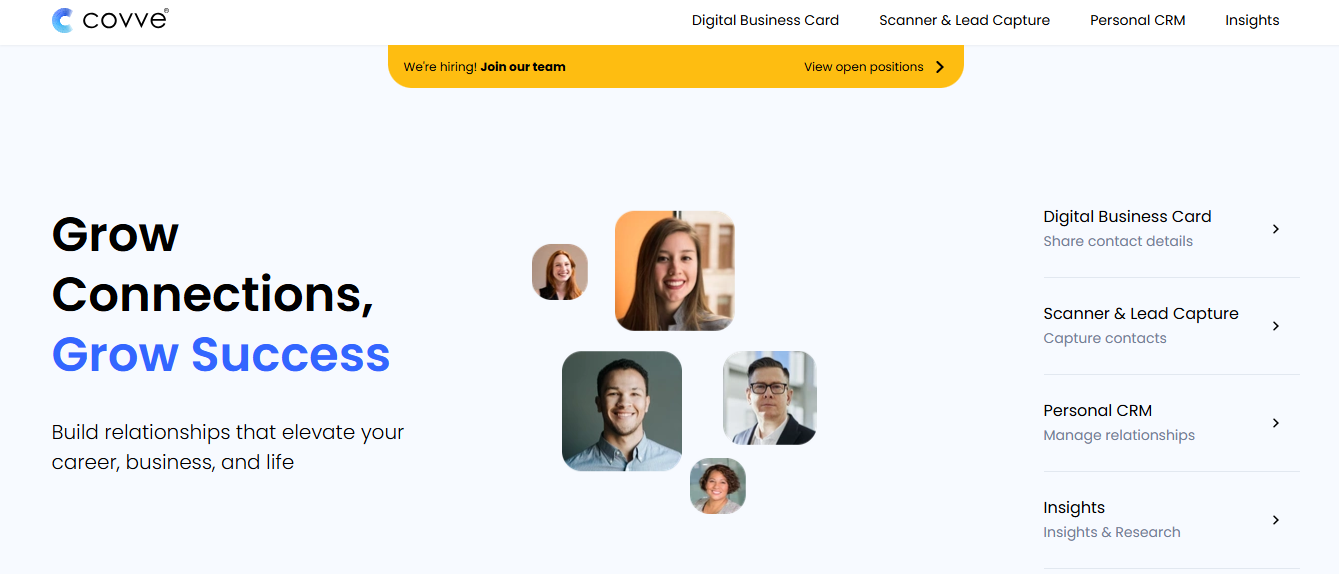
Covve provides a digital business card with business-friendly features, but the experience can feel fragmented. While you can get professionally designed card options by submitting your logo, much of the customization is paywalled and core features like contact management and analytics live across different apps. For a smooth team rollout, Covve requires more consolidation.
What works:
Where it falls short:
Covve covers the essentials but its fragmented architecture and paywalls make it less attractive for professionals who want a unified, polished solution.
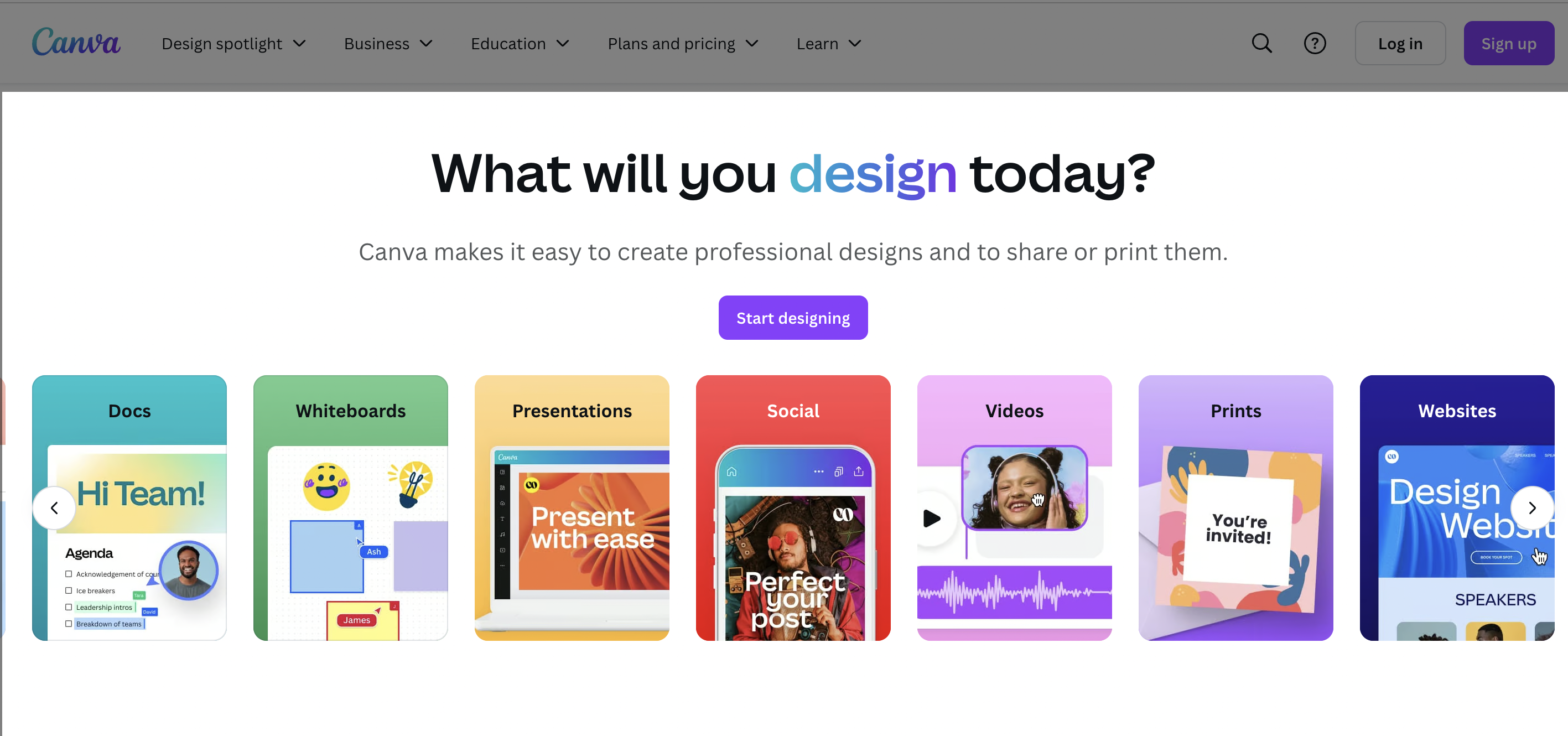
Canva makes it easy to design attractive business cards with a drag-and-drop interface and thousands of templates. It excels at visual design and producing print-ready files. Yet it does not offer live contact management, analytics, or ongoing updates, so it is not a substitute for a true digital business card platform.
What works:
Where it falls short:
Canva is ideal for designing attractive cards but not for professionals who want a dynamic, shareable, and trackable digital business card.

Adobe Express is a beginner-friendly design app that helps you create printable business cards quickly. It offers many templates and creative controls, yet it does not support contact sharing, analytics, or team provisioning. For designers or small teams that only need print files, it fits. For live networking and CRM sync, it does not.
What works:
Where it falls short:
Adobe Express excels as a design tool but is not a substitute for a modern digital business card platform that enables sharing, analytics, and CRM integration.

A solo consultant needs different features than a sales team. Ask how the platform will fit your workflow, whether you need CRM integration like Salesforce or HubSpot, and whether your team needs centralized admin controls. Test a few free versions such as the HiHello digital business card free plan to validate fit before you upgrade.
Top platforms let you upload many unique content pieces to a single profile. Add website links, social profiles, video demos, PDF brochures, appointment widgets, and short animated GIFs to convey personality and proof. HiHello app supports attachments and link cards that load quickly on mobile and desktop, so recipients see context not just contact fields.
Include every way people expect to save your info:
Add widgets for live activities and virtual backgrounds for video calls. HiHello, contactless card options make switching between QR sharing and NFC simple for different environments.
Choose a provider that records clicks, source referrer, device type, and time of visit. Good analytics show which links perform, which calls to action convert, and which industries engage most. Use UTM parameters and CRM sync to link card views to pipeline activity. HiHello analytics and click tracking give you that visibility so you can follow up with context.
Select a platform with flexible templates, color controls, and layout choices so your profile page looks like your website. Upload your logo, hero image, or a short intro video and preview how it renders on iPhone and Android. Some tools allow custom domains and CSS for enterprise polish; HiHello profile settings let you test different layouts quickly.
Verify provider compliance with SOC 2 Type 2, GDPR, and PIPEDA if you handle regulated data. Check how they store contacts, whether data is encrypted at rest and in transit, and how they handle opt-out and deletion requests. Look for admin controls, single sign-on options, and audit logs. HiHello lists compliance details and enterprise teams can require stricter access rules.
Strong platforms treat contacts as a CRM feed. Look for tagging, filtering, contact import and export, two-way sync with your CRM, and automated follow-up sequences. Use saved templates for messages and set reminders to reach out after a card view. HiHello contact management features integrate with Zapier and major CRMs to reduce manual work.
Compare free tiers, per-user pricing, and enterprise plans that include admin controls and white labeling. Check which features sit behind premium plans like advanced analytics, security controls, or bulk provisioning.
Calculate cost per user against the expected ROI from meetings booked and leads captured. Try the HiHello free plan then test a paid tier to see the lift before committing.
Probe support channels:
Walk through onboarding tasks like bulk user import, setting default templates, and configuring CRM sync while timing response speed. Ask for an implementation contact if you plan a company rollout. HiHello provides documentation and email support plus onboarding for higher tiers so you can measure response quality.
Try two or three free accounts, mirror your real use case, and compare how each performs over a week.
Paper cards sit in a drawer and never make it into your CRM. Mobilo turns every handshake into a digital contact that updates instantly. Teams that switch to smart digital business cards stop losing prospects at events and capture data during the moment of interest.
Mobilo uses NFC taps and QR code scans to share a virtual business card in seconds. Recipients get a profile link or a vCard they can add to their mobile wallet or address book, or they can receive the card via text or email. No app install required for the person you meet.
When a contact arrives, Mobilo enriches it with firmographic and intent signals, pulls public company data, and fills missing fields. It then scores that contact against your ICP so reps see priority leads first. That turns raw exchanges into qualified prospects without manual research.
Mobilo pushes contacts directly to your CRM via native integrations or APIs. Salesforce, HubSpot, Microsoft Dynamics, and others receive enriched records with activity logs and lead scores. You can trigger workflows, assign tasks, and start nurture sequences automatically.
Mobilo shows which cards generate taps, scans, shares, and conversions. You can track leads from first contact through pipeline stages and compare event ROI. Companies report higher contact capture rates and clearer attribution between event activity and sales outcomes.
Mobilo encrypts data in transit and at rest, supports role-based access, and offers options for consent capture and data retention policies to meet privacy regulations. You control what fields sync to the CRM and who sees analytics.
Both platforms provide a digital business card app, QR codes, vCard export, and NFC compatibility. Mobilo focuses on enterprise-scale deployment, automatic lead enrichment, ICP scoring, and deep CRM integration with event-level analytics. You still get mobile wallet compatibility, customizable templates, and contactless sharing that you see in virtual business card solutions.